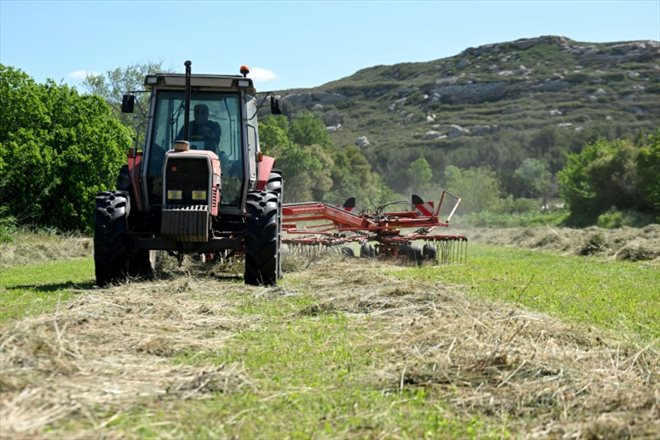Agronomy researcher François Charron opens a valve to flood a field near Salon-de-Provence in the Bouches-du-Rhône, June 23, 2023 (AFP / Nicolas TUCAT)
In the Crau plain, in Provence, a system of canals imagined in the 16th century makes it possible to irrigate hay meadows, treasures of biodiversity, and above all to supply a vast groundwater table, a balance weakened by urbanization and global warming.
Between Arles and Salon-de-Provence, in the south-east of France that Vincent Van Gogh and Paul Gauguin loved to paint, olive groves alternate with green expanses dotted with colorful flowers between March and the end of summer.
“The Crau hay is natural meadows that are decades old or even more for some; there are around forty species (of plants) identified”, explains to AFP Didier Tronc, director of the Committee of the Crau hay, whose family has been producing this highly sought-after fodder for generations.
This hay, which has 220 producers, was the first animal feed to obtain a Protected Designation of Origin (PDO). It is popular with horse breeders all the way to the Middle East, but also for cows, sheep or goats in cheese production.
In addition to its floristic richness, it “is richer in minerals and trace elements brought because we water with water from the Durance”, continues Didier Tronc just after putting the mown hay in “swath” (on line). exhaling a springtime smell of grass and flowers.
Contrary to certain agricultural irrigation practices, denounced by defenders of the environment for their pressure on groundwater (mega-basins etc.), the watering of hay meadows is part of a virtuous circle.

Agronomy researcher François Charron floods a field near Salon-de-Provence in the Bouches-du-Rhône, June 23, 2023 (AFP / Nicolas TUCAT)
Indeed, “it provides 70% of the recharge of the Crau groundwater, which supplies drinking water to 300,000 people” in Provence, underlines the Joint Syndicate for the management of this underground “lake” (Symcrau).
A valuable contribution at a time when 72% of tablecloths in France are below normal for the season, according to official figures released on Thursday.
– “Blood network” –
Everything starts from the Durance, this river which is born in the Alps and now flows into the Rhône. It once had its delta in the Crau plain, before changing course, leaving a rocky region, one of the last steppes in Europe.
But next to this dry Crau, criss-crossed by herds of sheep from autumn to spring, the “green” Crau developed from 1554, thanks to an ingenious system of canals designed by the engineer Adam de Craponne (1525-1576).
Near the Pas de Lamanon, a strategic place where a main canal still arrives more than 400 years later, Gaétan Guichard, director of the Association des arrosants de la Crau (Asco) explains: “The water is divided into a succession of canals from the south of the Alpilles to Arles and Salon-de-Provence like a blood network”, with a length of more than 500 kilometers.

“Crau hay” grown in the Crau plain thanks to a system of irrigation canals built in the 16th century, near Istres, in the Bouches-du-Rhône, on May 11, 2023 (AFP / Nicolas TUCAT)
Illustration to the “partitioners” of Eyguières and Salon-de-Provence: from these hydraulic structures leave different branches towards their respective destinations. They make it possible to regulate flows in order to share the resource between cities and agriculture.
“The virtue of this system is that it works solely by the force of gravity. Thanks to the slope, the water irrigates the territory without consuming energy”, underlines Mr. Guichard.
In winter and autumn, nothing is taken from the Durance, the canals are dry.
– “No waste” –
But in spring and summer, farmers have “water turns” every seven to twelve days, or the right to take at certain times. Thanks to the manual manipulation of hammers (valves), the water submerges the meadows.
“It’s not wasteful”, underlines François Charron, specialist in water management for the Agro Institute, a major school of agro-ecology in France, emphasizing the contribution to the water table and to biodiversity.
“Hay is a crop that does not use pesticides or nitrates, so we restore good quality water,” explains Didier Tronc.
By fighting against rising salt in this Mediterranean region and by supplying wetlands, this water contributes to biodiversity in Crau, where we find the only population of the bird ganga cata in France, a number of little bustards or the roller with blue feathers.
“The preservation of this avifauna depends (…) on maintaining the cultivation of Crau hay”, notes the National Inventory of Natural Heritage in France.

Haymaking near Istres in the Bouches-du-Rhône, May 11, 2023 (AFP / Nicolas TUCAT)
But in addition to urbanization which is eating away at natural and agricultural land, global warming is weighing heavily. In 2022, a year of historic drought, the canals closed earlier with hay production losses of up to 30%.
Watering associations, non-profit public interest establishments, track down leaks by maintaining and renovating the canals, a financially heavy task.
“We are also thinking about how to bring water at the right time, to see if automatic hammer machines or detector stakes can help us with better management”, explains François Charron, who runs the Domaine du Merle, a scientific and educational farm combining the production of hay, sheep breeding and school of shepherds under the aegis of the Agro Institute (of Montpellier).
But, he insists, “bringing less irrigation to the meadows can jeopardize the balance in the Crau plain”.
© 2023 AFP
Did you like this article ? Share it with your friends with the buttons below.




